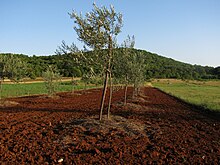Terra rossa
Terra rossa ( Italian for red earth; Latin terrae rossae ) or limestone red clay is a type of soil with a bright red color that is often found in the Mediterranean region . Although poor in humus , it is relatively fertile if there is sufficient water supply .
Origin and composition
The soil-forming processes responsible for this soil mostly took place in the Neogene before max. 15 million years ago and mainly consisted of the leaching of the carbonates contained in the parent rock with simultaneous enrichment of clay minerals and iron oxides . The latter also includes hematite , which is why the red color came about. It is assumed that terrae rossae arise from rendzinen in the course of a very long soil formation .

More recent mineralogical and chemical analyzes of the formation of terra rossa in the Mediterranean area , however, show the entry of red mineral dust from the Sahara and Sahel regions, which occurred between 12,000 and 25,000 years ago. This would mean that these soils would be significantly younger, and the previously discussed soil formation processes that may have been involved would have to be supplemented by another point:
- Theory of the autochthonous residual accumulation of the non-carbonate components when the carbonate rock is weathered
- Ascendancy theory: accumulation of iron and aluminum hydroxides through capillary ascent from the rock bedrock
- Theory of allochthonous soil enrichment: Soil was formed allochthonously, e.g. B. by entering aeolian dust
The scientific classification of terra rossa varies depending on your system: the international soil classification World Reference Base for Soil Resources (WRB) assigns them to Chromic Luvisols or Chromic Cambisols (ie the colored Luvisolen and Cambisolen ), while together in the German Soil Science with the soil type Terra fusca belongs to the class Terrae calcis . The class Terrae calcis counts together with z. B. Brown earth , black earth etc. to the department of terrestrial soils .
The horizon sequence is Ah / Tu / cC.
- Ah: Mineral topsoil horizon with only a little humus (max: 10%), as this is broken down in winter due to the lack of frost.
- Tu: Carbonate rock ( limestone or dolomite ) has dissolved in rain or soil water and the impurities contained therein, clay minerals , remain and form the main component of this horizon with a content of at least 65% by mass. It has a brownish red color, which is due to an accumulation of hematite (up to> 5%).
- cC: little weathered carbonate rock (limestone or dolomite) with at least 75 mass% carbonate.
use
The terra rossa is quite good soil, which dries out on the surface in summer, but because of its thickness (> 1 m) is sufficiently deep to store enough water even in drought . It is therefore well suited for agriculture because of the richness of clay in the subsoil.
Web links
- Soil horizons of terrestrial soils ( Memento from March 28, 2005 in the Internet Archive ) (PDF file; 33 kB)
- photos
- Mediterranean region (PDF file; 717 kB)
literature
- W. Amelung, H.-P. Blume , H. Fleige, R. Horn, E. Kandeler , I. Kögel-Knabner , R. Kretschmar, K. Stahr , B.-M. Wilke: Scheffer / Schachtschabel textbook of soil science. 17th edition. Heidelberg 2018. ISBN 978-3-662-55870-6 .
Individual evidence
- ↑ African Dust Caused Red Soil in Southern Europe ( page no longer available , search in web archives ) Info: The link was automatically marked as defective. Please check the link according to the instructions and then remove this notice. , EGU Newsletter, Issue 33, Dec. 2010
- ↑ Muhs et al. : The role of African dust in the formation of Quaternary soils on Mallorca, Spain and implications for the genesis of Red Mediterranean soils. Quaternary Science Reviews, Volume 29, Issues 19-20, September 2010, Pages 2518-2543
